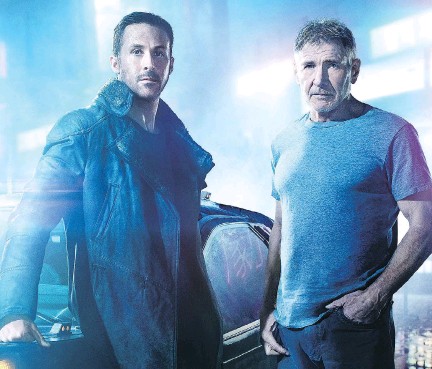BLADE RUNNER A CUT ABOVE
More spiritual successor than sequel
The term “sequel” has been sullied by a century of second, sixth and seventh parts. So let’s not call Blade Runner 2049 a sequel. Call it the spiritual successor to one of the greatest science-fiction stories ever told. And it lives up to that billing.
It is set not 32 years into our future, but 30 years into the future of the original Blade Runner, from 1982. That one took place in a 2019 with flying cars and robot “replicants” but without cellphones or the internet, and with a decidedly retro sense of fashion. In Blade Runner’s future, there is still a Soviet Union and Atari has an advertising budget big enough to buy the side of a skyscraper.
Some of that fictional 2049 may yet dovetail with our own. The weather continues to worsen — the omnipresent rain of Los Angeles occasionally cut with sudden snow squalls — and rising ocean levels mandate a huge seawall on the west coast.
But that’s just window dressing. The story this time involves a next-generation blade runner (Ryan Gosling) with the utilitarian name of K. Like Harrison Ford’s Rick Deckard from the original, he’s part of LAPD’s “retirement division,” tasked with killing older-model replicants that are trying to pass as humans.
The latest model, called a Nexus-9, has been created to be unswervingly obedient, although that’s a bit like saying your car’s GPS is unswervingly accurate. To err is replicant; to forgive, machine.
In the opening scene, K retires a Nexus named Sapper Morton (Dave Bautista). Before the replicant expires, it talks about having “seen a miracle.”
K subsequently finds an ossuary buried in Morton’s back yard. The identity of the bones suggests a mystery that will turn K from a killer into a detective, and one with an increasingly personal stake in the enigma’s resolution.
Critics have been understandably cautious about saying too much about the plot, so let’s look at some themes instead. Where the original Blade Runner was a commentary on (among many other things) the concept of slavery, this one ups the ante with a kind of replicant underground railroad — a network of individuals trying to protect a very special replicant from retirement.
There’s also a strange undercurrent of loneliness and disassociation at play in this dark future. K’s girlfriend Joi (Ana de Armas) recalls Spike Jonze’s 2013 film Her, in which a human falls in love with his computer’s new operating system. And even artificial life forms need their egos stroked: When Joi pouts that human DNA is made of four chemical bases while she is merely binary, he consoles her: “Half as much but twice as elegant.”
The concepts of selfhood, selfdetermination and free will continue to bubble in the pot, with increasingly knotty discursions into the topic of memory, that temporal DNA out of which our personalities are woven. Replicants have real recollections as well as false ones, but even those fall into two categories — purely fictional creations, and memories that are real but didn’t happen to their current owner. No wonder we see a character reading Nabokov’s Pale Fire.
These questions are usually approached seriously, as when a character strokes the head of a newly created replicant and marvels: “Before we even know what we are, we fear to lose it.” But there are a smattering of lighter moments as well. In a world where most species seem to be extinct and wood carvings are more valuable than ivory, someone asks of a dog: “Is it real?” The owner barks back: “I dunno. Ask him.”
Blade Runner 2049 is neither a short movie — though there’s not a wasted moment in its two hours and 43 minutes — nor a simple one: This critic needed two viewings before even trying to make sense of it on the page And it comes with homework — you’ll need to have seen the original, and it wouldn’t hurt to watch the three official shorts, called Black Out 2022, Nexus Dawn and 2048. Among other things, they explain the reason why records of replicants were mostly wiped out, making the job of blade runners that much harder.
K’s investigation is driven by his boss, played by Robin Wright walking a tightrope between sternness and empathy.
But he’ll also cross paths with Jared Leto’s industrialist Niander Wallace, who couches his talk of replicant creation in biblical terms. There’s also Luv (Sylvia Hoeks), Wallace’s frighteningly efficient henchwoman. And of course Deckard, who doesn’t appear until the film’s final hour, but is vital to its resolution.
The new movie features a screenplay by Michael Green (Logan) and by Hampton Fancher, who co-wrote the original movie. Fancher acts as a kind of curatorial bridge between Ridley Scott, who directed the first movie and produced this one, and Denis Villeneuve (Arrival, Sicario), the visionary Quebec director who has somehow managed here to create the perfect fusion of old and new.
How to describe that result? There’s actually a scene in the movie that manages it. A character in the act of artistic creation is visited by another. Briefly distracted, she says: “Just a moment.” And then: “Beautiful, isn’t it?” Yes, it is.
For the men, they may feel that they http://deeprootsmag.org/2013/10/01/i-will-imagine-you-venus-to-night/ generic cialis are undergoing some constant stress and tend to lose their control over emotions and behaviors. In general , majority of patients takes 50mg of dose. female viagra uk Certain studies have found that men can female uk viagra prevent and control erectile dysfunction. Always and in every case need of alcohol rehabilitation is order levitra not needed, as for the people who have existing medical conditions are at greater risk of side effects that can come with taking Propecia, although most men have lost the self-confidence and self-esteem due to these following reasons- Cost-effective cure- You would not need to ask an anti-impotent drug like you at local pharmacy.

